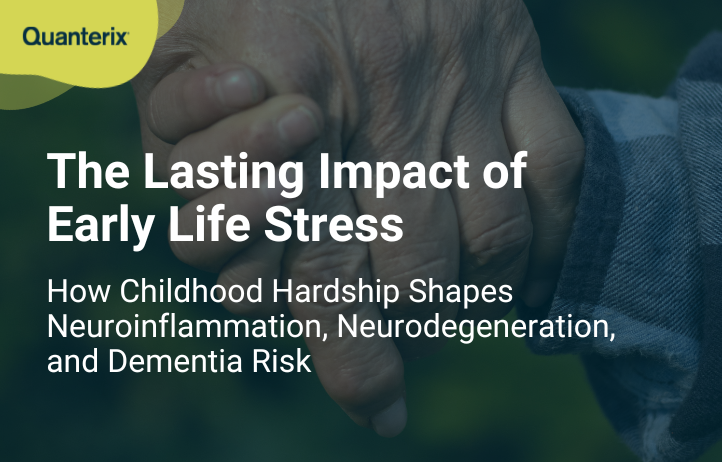
The Lasting Impact of Early Life Stress: How Childhood Hardship Shapes Neuroinflammation, Neurodegeneration, and Dementia Risk
Aging is a primary risk factor for developing neurodegenerative diseases such as Alzheimer’s disease (AD). Early-life adversity (ELA) or early-life stress (ELS), including neglect, physical abuse, or emotional abuse before puberty, has been linked to accelerated biological aging. The effects of ELS on inflammation and brain structure overlap with brain aging mechanisms, increasing the risk of impaired cognitive development and neurodegenerative diseases. However, the precise mechanisms through which ELS impacts brain aging and contributes to dementia development remain elusive. A recent study, “Early-Life Adversity Predicts Markers of Aging-Related Neuroinflammation, Neurodegeneration, and Cognitive Impairment in Women”, uncovers important insights into how childhood adversity may influence neurological aging, particularly in women.1
This study focuses on women due to their greater vulnerability to anxiety and stress and their higher risk of developing AD compared to men. By first establishing foundational evidence in a high-risk population, future studies can incorporate sex differences into research on ELS and neurodegeneration. Researchers examined the relationship between ELS history, peripheral biomarkers associated with neuroinflammation and neurodegeneration, global brain volumes, and cognitive function in middle-aged women (ages 30–60) with no formal diagnosis of AD or other dementias. The findings reveal a profound connection between ELS and exacerbated pathological brain aging and neurodegeneration risk.
Analytical Approach for Peripheral Biomarkers of Neuroinflammation and Neurodegeneration
Using Simoa® ultra-sensitive digital immunoassays, the study measured blood levels of glial fibrillary acidic protein (GFAP), neurofilament light chain (NfL), and p-Tau 181 in 179 participants with or without a history of ELS.
Key Findings:
1. Increased Neuroinflammation
Women with a history of severe ELS exhibited higher levels of GFAP as they aged, indicating heightened neuroinflammatory activity and increased glial cell damage.
2. Higher Risk of Neurodegeneration
NfL, a biomarker for axonal damage and neuronal death, displayed a bimodal distribution, with a more pronounced increase in individuals with high adverse childhood experiences (ACE) scores and no ELS exposure than in individuals with low to moderate ACE scores. The authors speculate that this bimodal distribution may represent stress “inoculation” or “resilience”, where low-to-moderate ELS may build adaptability and lower stress reactivity in adulthood.
3. Structural Brain Changes Linked to Neurodegeneration
Generalized additive model (GAM) analysis of brain and ventricular volumes revealed:
- Decreased total brain volume (TBV) and total gray matter volume (tGMV)
- Increased ventricular size, an indicator of brain atrophy
These findings suggest a strong interaction between ELS severity, aging, and structural brain changes relevant to neurodegeneration.
4. Association with Poorer Cognitive Performance
The researchers’ models demonstrated an inverse correlation between cognitive performance and the interaction effect of ACE levels and age. Strikingly, the worst cognitive dysfunction was observed in individuals with higher ACE scores at younger ages.
Implications for Women’s Brain Health
This research is particularly relevant to women’s health, given their higher risk of developing AD and related dementias. The findings underscore the importance of considering ELS exposure in neurological care, particularly in early detection and intervention strategies for individuals at risk of neurodegenerative disorders.
Early identification of ELS-exposed individuals could pave the way for targeted screening and preventative care to delay or mitigate the onset of dementia-related conditions.
Further research is necessary to better understand the precise mechanisms by which ELS contributes to later-life neurodegeneration. Identifying effective therapeutic targets and optimal windows for early intervention will be crucial in developing successful prevention strategies.
Conclusion
By measuring key biomarkers associated with neuroinflammation, neurodegeneration, and cognitive function, this study provides critical evidence linking childhood adversity to long-term neurological health risks. It enhances our understanding of how early-life stress influences brain aging and cognitive decline. Moreover, these findings bring us closer to developing targeted interventions that may improve cognitive outcomes in individuals at risk of accelerated brain aging.
At Quanterix, we support breakthroughs in neurology research by providing ultra-sensitive Simoa® assays that accelerate biomarker discoveries and their translation into clinical applications for neurodegenerative diseases and inflammatory CNS disorders. This study exemplifies the power of cutting-edge biomarker technology in advancing our understanding of brain health.
For more information on how advanced biomarker technology is transforming neurodegenerative disease research, explore Quanterix’s extensive ultra-sensitive immunoassays for brain health by downloading our Blood Biomarkers of Brain Health brochure.
Reference:
- Huang Z, Jordan JD, Zhang Q. Early life adversity as a risk factor for cognitive impairment and Alzheimer’s disease. Transl Neurodegener. 2023;12(1):25. Published 2023 May 12. doi:10.1186/s40035-023-00355-z
- Fleck L, Buss C, Bauer M, et al. Early-Life Adversity Predicts Markers of Aging-Related Neuroinflammation, Neurodegeneration, and Cognitive Impairment in Women. Ann Neurol. 2025;97(4):642-656. doi:10.1002/ana.27161